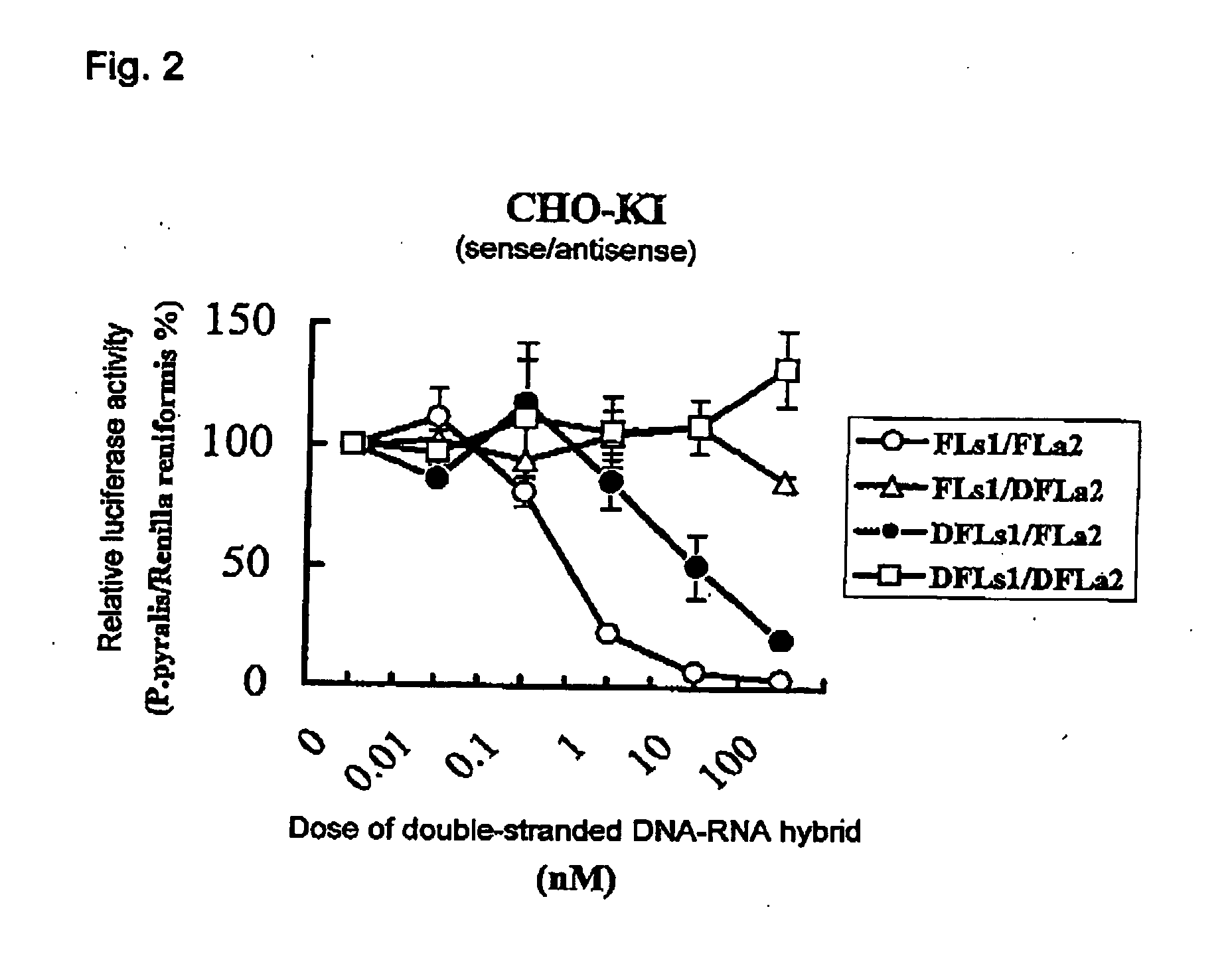Method of inhibiting gene expression
a gene expression and gene technology, applied in the field of gene expression inhibition, can solve the problems of high cost of production and easy degradation of rna by ribonuclease, and achieve the effect of improving stability
- Summary
- Abstract
- Description
- Claims
- Application Information
AI Technical Summary
Benefits of technology
Problems solved by technology
Method used
Image
Examples
example 1
Inhibition of Expression of Target Gene by Double-Stranded DNA-RMA Hybrid Transfected into CHO-KI Cell
[0074] (1) Preparation of DNA-RNA Hybrid Type Double-Stranded Polynucleotide
[0075] A luciferase gene of Photinus pyralis (P. pyralis luc gene: accession number: U47296) was used as a target gene and pGL3-Control vector (manufactured by Promega) was used as an expression vector comprising the same. The gene fragment of P. pyralin luc gene lies between a promoter of SV40 and poly A signal in the vector. A luciferase gene of Renilla reniformis was used as an indicator gene and pRL-TK (manufactured by Promega) was used as an expression vector comprising the same.
[0076] The sense strand of 21 nucleotides for use in the preparation of the double-stranded polynucleotide used in the present Example is represented by SEQ ID NO: 1 (DNA) or SEQ ID NO: 2 (RMM). Moreover, the antisense strand is represented by SEQ ID NO: 3 (DNA) or SEQ ID NO: 4 (RNA). With regard to these sequences, a chimera...
example 2
Inhibition of Expression of Target Gene by DNA-RNA Chimera Type Double-Stranded Polynucleotide Transfected into Drosophila S2 Cell
[0084] (1) Preparation of DNA-RNA Chimera Type Double-Stranded Polynucleotide
[0085] A luciferase gene of Photinus pyralis (P. pyralis luc gene: accession number: U47296) was used as a target gene. Moreover, a luciferase gene of Renilla renifomis was used as an indicator gene. Furthermore, the expression vectors described in Example 1 were also used as expression vectors.
[0086] The sense strand of 21 nucleotides for use in the preparation of the double-stranded polynucleotide used in the present Example is represented by SEQ ID NO: 1 (DNA) or SEQ ID NO: 2 (RNA). Moreover, antisense strand is represented by SEQ ID NO: 3 (DNA) or SEQ ID NO: 4 (RNA). With regard to these sequences, chimera type single-stranded polynucleotides of DNA or RNA were prepared as shown in FIG. 1. Synthesis of these polynucleotides was entrusted to Genset K. K. via Hitachi Instrum...
example 3
Inhibition of Gene Expression by DNA-RNA Chimera Double-Stranded Polynucleotide Transfected into Human HeLa Cell and Human HEK293 Cell
[0095] (1) Preparation of DNA-RNA Chimera Type Double-Stranded Polynucleotide
[0096]P. pyralis luc gene was used as a target gene and pGL3-Control vector (manufactured by Promega) was used as an expression vector containing the same. Moreover, a luc gene of Renilla reniformis was used as an indicator gene and pRL-TR (manufactured by Promega) was used as an expression vector containing the same.
[0097] The sense strand of 21 nucleotides for use in the preparation of the double-stranded polynucleotide used in the present Example is represented by SEQ ID NO: 1 (DNA) or SEQ ID NO. 2 (RNA). Moreover, the antisense strand is represented by SEQ ID NO: 3 (DNA) or SEQ ID NO: 4 (RNA). With regard to these sequences, chimera type single-stranded polynucleotides of DNA or RNA were prepared as shown in FIG. 1. Synthesis of these polynucleotides was entrusted to G...
PUM
| Property | Measurement | Unit |
|---|---|---|
| Gene expression profile | aaaaa | aaaaa |
| Specific strength | aaaaa | aaaaa |
Abstract
Description
Claims
Application Information
 Login to View More
Login to View More - R&D
- Intellectual Property
- Life Sciences
- Materials
- Tech Scout
- Unparalleled Data Quality
- Higher Quality Content
- 60% Fewer Hallucinations
Browse by: Latest US Patents, China's latest patents, Technical Efficacy Thesaurus, Application Domain, Technology Topic, Popular Technical Reports.
© 2025 PatSnap. All rights reserved.Legal|Privacy policy|Modern Slavery Act Transparency Statement|Sitemap|About US| Contact US: help@patsnap.com



